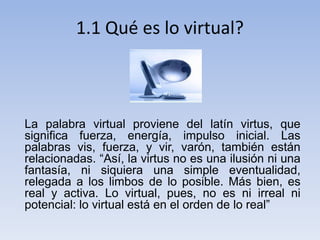The word “virtual” is one of the most commonly used terms in today’s digital age. It is a word that has found its way into our everyday conversations, and yet, many people still struggle to fully grasp its meaning. So, what does the word “virtual” actually mean?
At its core, “virtual” refers to something that is not physically present but is made to appear as if it were. In other words, it is something that exists in a digital or simulated form. This can range from virtual reality experiences to online meetings, and even virtual assistants like Siri or Alexa. As technology continues to advance, the concept of the virtual world is becoming increasingly prevalent in our lives, making it more important than ever to understand what the term truly means.

What Does the Word “Virtual” Mean?
The word “virtual” has become increasingly popular in recent years, and is used to describe a variety of different concepts and technologies. In its most basic sense, virtual refers to something that is not real, but is created with the use of computers or technology. It can also refer to an experience that simulates a real-life situation. Virtual can also refer to a form of reality that is experienced through technology, such as virtual reality.
Virtual Environments
A virtual environment is a simulated environment that is created with the use of computers and technology. This type of environment can be used to create a realistic experience of a real-world situation. Virtual environments are commonly used in gaming, as well as for educational and training purposes. In a virtual environment, the user is able to interact with the environment and take part in activities as if they were in a real-world situation.
Virtual environments can also be used to create simulations of real-world scenarios. This type of simulation is often used in research and development, as it allows researchers to test ideas and theories without having to use real-world resources. Virtual environments can also be used to create virtual tours, allowing users to explore a virtual version of a physical location.
Virtual Reality
Virtual reality (VR) is a type of simulated reality that is experienced through the use of technology. With virtual reality, users are able to interact with a three-dimensional simulated environment. In a virtual reality experience, users are able to explore a simulated environment and take part in activities as if they were in a real-world situation. Virtual reality is commonly used in gaming, as well as for educational and training purposes.
Virtual reality can also be used to create virtual tours, allowing users to explore a virtual version of a physical location. Virtual reality can also be used to create simulations of real-world scenarios, allowing users to test ideas and theories without having to use real-world resources. Virtual reality is also used in medical research, allowing doctors and researchers to test treatments without having to use real-world resources.
Conclusion
In conclusion, the term “virtual” can be used to describe a variety of different concepts and technologies. Virtual can refer to something that is not real, but is created with the use of computers or technology. It can also refer to an experience that simulates a real-life situation. Virtual can also refer to a form of reality that is experienced through technology, such as virtual reality. Virtual environments and virtual reality are both used for a variety of purposes, such as gaming, education, training, and research.
Frequently Asked Questions about “qué significa la palabra virtual?”
The following FAQs provide information about the term “virtual,” which is commonly used to describe digital technology and experiences.
What does the word “virtual” mean?
The word “virtual” is an adjective used to describe something that is not physically existing but made to appear or feel as if it does exist. This can refer to experiences and objects that are simulated or created through the use of digital technology. For example, a virtual reality game is not a real experience, but it simulates one. Likewise, virtual objects such as 3D models are not real, but they look and feel as if they are.
How is the word “virtual” used?
The word “virtual” is often used to refer to digital technology and experiences. For example, virtual reality (VR) and augmented reality (AR) are both immersive, digital experiences that use computer-generated images and sounds to create a simulated environment. Other uses of the word “virtual” include virtual machines, virtual networks, virtual storage, and virtual currency.
What are some examples of virtual experiences?
Some examples of virtual experiences include virtual reality games, virtual tours, virtual meetings, virtual classrooms, and virtual worlds. Virtual reality games are immersive, computer-generated experiences that use 3D graphics, sound, and haptic feedback to create a realistic environment. Virtual tours are digital experiences that allow users to explore a physical space, such as a museum, without actually being there. Virtual meetings allow people to meet and collaborate over the Internet. Virtual classrooms are digital learning environments where students can attend lectures, participate in discussions, and complete assignments. Virtual worlds are simulated environments where users can interact, explore, and create.
What are the benefits of virtual experiences?
Virtual experiences offer a range of benefits, from cost savings to increased efficiency. For example, virtual reality games can provide users with an immersive experience without the need for expensive hardware or travel. Virtual tours can provide users with a more interactive experience than traditional tours. Virtual meetings can reduce the cost and time associated with in-person meetings. Virtual classrooms can make learning more accessible, as students can attend classes from anywhere in the world. Virtual worlds can provide users with a safe and creative space to explore and create.
What are the risks of virtual experiences?
Virtual experiences can pose some risks, including cyber security threats, privacy concerns, and potential health risks. Cyber security threats can include viruses, malware, and other malicious software. Privacy concerns can arise if users’ data is not properly secured. Potential health risks can include eye strain, motion sickness, and headaches caused by extended exposure to virtual reality. It is important to be aware of the potential risks and take proper precautions when using virtual experiences.

¿Qué Significa Virtual?
In conclusion, the word “virtual” is a term that has become increasingly prevalent in the modern world, particularly in the realm of technology. While its meaning may seem straightforward at first glance, there are many nuances to its definition that make it a complex and fascinating concept to explore. From virtual reality to virtual assistants, the applications of this word are vast and ever-evolving.
As we continue to navigate the digital landscape, understanding the true meaning of “virtual” will become increasingly important. Whether we are using virtual platforms to connect with others or exploring new dimensions through virtual reality technology, this term will undoubtedly play a significant role in shaping our experiences. So, let us embrace the power of the virtual world and all that it has to offer, as we continue to push the boundaries of what is possible in the 21st century.



